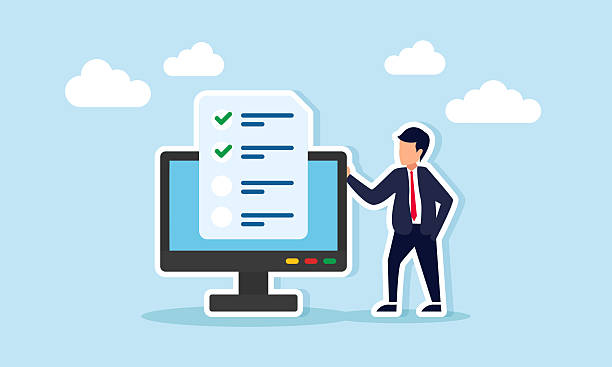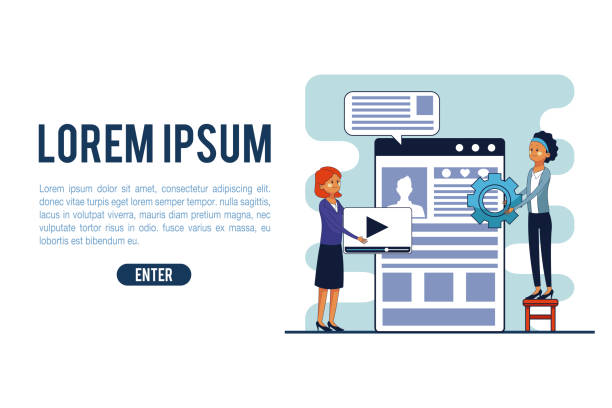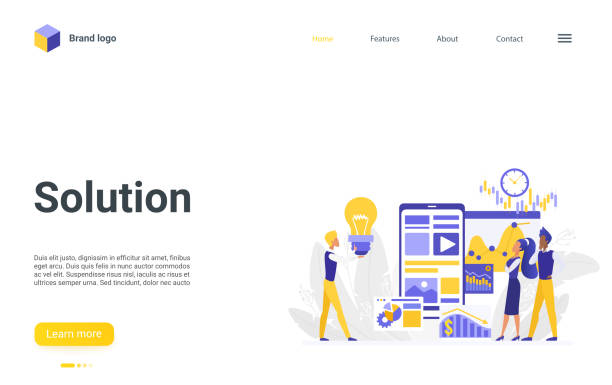Importance and Necessity of Multilingual Website Design in Today’s World

In today’s interconnected world, expanding businesses and reaching global markets has become more important than ever.
One of the most crucial tools to achieve this goal is multilingual website design.
This approach not only allows companies to connect with a wider audience worldwide but also strengthens their online presence.
#Multilingual_website_design is no longer a competitive advantage; it’s a necessity, as it enables users to view your website content in their native language, which in turn significantly improves user experience.
By providing content in various languages, you’ll be able to meet the needs and expectations of a wide range of users and gain their trust.
This strategy paves the way for entering international markets and creates new opportunities for business growth and development.
In fact, overlooking this aspect can lead to losing a significant share of the global market.
World languages are a gateway to different cultures and needs, and each holds its own market potential.
Does your current corporate website not reflect your brand’s credibility and power as it should? Rasaweb solves this challenge for you with professional corporate website design.
✅ Increase visitor credibility and trust
✅ Targeted attraction of more customers
⚡ Click for a free consultation!
Competitive Advantages and Challenges of Multilingual Site Implementation

Implementing a multilingual site brings countless competitive advantages for businesses.
Increased global reach, improved international SEO, enhanced user trust, and consequently, growth in conversion rates are just some of these benefits.
When your website is available in multiple languages, search engines can present it to users in different geographical regions with various languages, which significantly helps with Search Engine Optimization (SEO).
However, this process is not without challenges.
Content management, high-quality translation, technical issues related to international SEO (such as correct use of hreflang tags), and maintaining brand consistency across different languages are among the main challenges.
Choosing appropriate tools for translation and content management, collaborating with native and specialized translators, and closely monitoring translation quality to prevent cultural misunderstandings are some of the solutions to overcome these challenges.
Success in this area requires meticulous planning, suitable investment, and consistent execution.
Ignoring any of these aspects can lead to the loss of potential benefits.
Technical Considerations in Multilingual Site Building and Platform Selection

When building a multilingual site, technical considerations are of particular importance.
Choosing the appropriate URL structure (such as subdomains, subfolders, or top-level domains for each language), correctly using hreflang tags to inform search engines about different language versions of pages, and implementing a user-friendly language switcher are among the most important technical aspects.
The hreflang tag helps Google understand which version of a page is suitable for which language and geographical region, and prevents duplicate content issues.
Selecting a Content Management System (CMS) that fully supports multilingual capabilities is also crucial.
WordPress with plugins like WPML, Drupal with native capabilities, and Joomla are examples of popular CMSs that provide numerous features for creating multilingual websites.
Each of these platforms has its own advantages and disadvantages that should be reviewed based on project needs and budget.
Making the right decision at this stage forms the foundation of a successful multilingual website.
| Platform | Multilingual Support | Ease of Use | Scalability | Approx. Cost (Setup) |
|---|---|---|---|---|
| WordPress (with WPML) | Very Good (with plugin) | High | Medium to High | Medium |
| Drupal | Excellent (native) | Medium | High | High |
| Joomla | Good (native) | Medium | Medium | Medium |
| Shopify (with plugin) | Good (with plugin) | Very High | High | Medium to High (monthly subscription) |
Localization and Content Translation Strategies

Simply translating content is not enough for the success of a multilingual website; localization must also be considered.
Localization goes beyond word-for-word translation and involves adapting content to the culture, values, idioms, and even currency and historical context of the target region.
This gives users a greater sense of connection with your brand and increases conversion rates.
For this, collaboration with native and specialized translators who are aware of subtle cultural differences is essential.
Also, using Translation Management Systems (TMS) can organize the process and ensure quality.
One of the most important points in this regard is to avoid raw machine translations for core and sensitive content, and instead, invest in high-quality human translations.
Although AI tools have advanced in translation, they are not yet capable of fully grasping cultural nuances, humor, and marketing subtleties that are vital for effective communication with the audience.
This helps ensure your website is not only understandable but also culturally relevant and appealing.
Don’t have a corporate website yet and missing out on online opportunities? With professional corporate website design by Rasaweb,
✅ Double your business’s credibility
✅ Attract new customers
⚡ Free consultation for your corporate website!
Common Mistakes in Multilingual Site Development and Solutions to Avoid Them

In the process of multilingual site development, there are common mistakes that can harm your efforts.
One such mistake is neglecting international SEO; for example, improper use of hreflang tags or an unsuitable URL structure leading to duplicate content issues.
Another mistake is relying solely on machine translation without human review, which can result in inaccurate, unnatural, or even offensive translations.
Additionally, failing to localize images, videos, and other visual elements of the website can degrade user experience and make the website appear unprofessional.
To avoid these mistakes, you should formulate a comprehensive strategy for international SEO from the outset, use native and professional translators, and localize all website elements, including date and time formats, currency, and phone numbers.
Trial and error and gathering feedback from native users can also help in identifying and resolving issues.
Another mistake is not planning for multilingual content updates, which can lead to outdated information in some languages.
Latest Trends and Technologies in Multilingual Site Management

The digital world is rapidly evolving, and this also affects multilingual site management.
One of the most significant trends is the increasing use of Artificial Intelligence (AI) and machine learning in translation processes.
AI-powered translation tools can now provide high-quality initial translations that require less editing and speed up the process.
Additionally, the emergence of Headless CMS platforms, which allow separating the backend (content) from the frontend (display), has created greater flexibility in managing multilingual content for various devices and channels (web, mobile, application).
Content personalization based on user language and geographical location is another growing trend that helps enhance user experience.
These technologies are shaping the future of multilingual website design and management, enabling businesses to reach global markets more efficiently.
Enhancing User Experience and User Interface in Multilingual Portals

A successful multilingual portal not only provides translated content but also ensures a flawless user experience (UX) and user interface (UI).
UI design should allow for easy language selection and be accessible on every page.
The language switcher should be clear and recognizable, preferably using full language names (like “فارسی”, “English”) instead of flags, as flags do not always represent a specific language and can cause confusion.
Fonts, text direction (right-to-left for Persian and Arabic, left-to-right for English and many other languages), and even colors should be consistent with the target audience’s culture.
Responsive design and loading speed optimization are also crucial for all language versions so that users worldwide can quickly and easily access information.
Attention to details such as date and time formats, currency, and phone numbers in each geographical region, are other important points for a localized UX.
| UI/UX Element | Importance Explanation | Implementation Tips |
|---|---|---|
| Language Switcher | Allows easy language change at any time | Should be placed in the header or footer, use full language names, be clear and accessible. |
| Text Direction (RTL/LTR) | Matches the reading direction of the target language (right-to-left or left-to-right) | Use the dir=”rtl” attribute for languages like Persian, Arabic, and Hebrew. |
| Fonts and Typography | Readability and visual appeal in all languages | Choose fonts that fully support characters of all target languages. |
| Image and Video Localization | Conveys visual messages appropriate to local culture and sensitivities | Use images and visual content that are meaningful and culturally appropriate for native audiences. |
Measuring Success and Analyzing International Website Performance

After creating a multilingual website, it is crucial to measure its performance and analyze its success.
Analytics tools like Google Analytics allow you to see which countries and languages users access your website from, what the bounce rate (Bounce Rate) is for each language version, and how much time users spend in each section of your website.
By reviewing this data, you can identify the strengths and weaknesses of each language version and optimize your strategies for continuous improvement.
For instance, if you observe a low conversion rate in a specific language, you might need to review translation quality, further localize content, or even improve the UI design for that particular language.
Measuring traffic, conversion rates, visit duration, and user engagement for each language are key metrics that should be regularly examined to ensure the effectiveness of your multilingual strategy.
Are you concerned about your e-commerce site’s low conversion rate and not achieving your desired sales?
Rasaweb is your specialized solution for a successful e-commerce website.
✅ Significant increase in conversion rates and sales
✅ Professional and user-friendly design to satisfy customers
⚡ Ready for a transformation in online sales? Get a free consultation!
Inspiring Examples of Successful Global Multilingual Sites

Examining successful multilingual site examples can be inspiring and a valuable guide for future projects.
Companies like IKEA and Apple are prominent examples that have multilingual and localized websites.
IKEA has become a global brand by offering its products and services in dozens of languages and considering cultural differences in each region.
Apple also provides an unparalleled user experience by maintaining brand consistency while localizing content for different markets.
Case studies of these companies show that success in the multilingual world requires a comprehensive approach and attention to all technical, content, and cultural aspects.
These examples prove that with proper planning and execution, significant success can be achieved in global markets.
Future of Multilingual Website Design and Final Recommendations

The future of multilingual website design is intertwined with advancements in AI, machine learning, and new technologies in translation and localization.
It is expected that higher-quality automatic translation tools with smarter localization capabilities will make the process easier for businesses.
Additionally, with the growing importance of personalized user experience, multilingual websites must be able to provide highly precise content relevant to individual user preferences.
Final recommendations for success in this field include: design for multilingualism from the outset, rather than considering it an added feature.
Focus on translation and localization quality and use professional translators.
Pay special attention to international SEO and technical optimization.
Continuously monitor and analyze website performance and improve based on data.
With this approach, your multilingual website can be a strong bridge for connecting with global markets and achieving sustained success, strengthening your position in international competition.
Frequently Asked Questions
| Question | Answer |
|---|---|
| 1. What is multilingual website design? | The process of creating a website whose content is available in multiple different languages so that users from all over the world can interact with the site in their own language. |
| 2. Why should we make our site multilingual? | To expand the market, attract international audiences, improve SEO in global search results, and increase brand credibility and professionalism. |
| 3. What are the methods for implementing a multilingual site? | Using subdomains (e.g., fa.example.com), subdirectories (e.g., example.com/fa/), URL parameters (e.g., example.com?lang=fa), or country-code domains (e.g., .ir, .de). |
| 4. Is multilingual website SEO different? | Yes, it requires international SEO strategies such as using the hreflang tag, appropriate URL structure for each language, and keyword research for each language. |
| 5. What points should be considered when choosing languages? | Language selection should be based on target markets, audience demographics, and current website traffic analysis data. |
| 6. What are the common problems in multilingual website design? | Issues related to SEO, translation quality, content management, Right-to-Left (RTL) and Left-to-Right (LTR) support, and user experience. |
| 7. What is the role of CMS in multilingual sites? | Modern Content Management Systems (CMS) (such as WordPress with multilingual plugins or Drupal) offer built-in features or powerful plugins for easy content management in multiple languages. |
| 8. How should content translation be done? | Translation should be done by native and professional translators, not just machine translation, to ensure local tone, culture, and idioms are respected. |
| 9. How is language switching done on multilingual sites? | Typically, a Language Switcher is used in the site’s header or footer, allowing users to easily select their desired language. |
| 10. Is responsive design important for multilingual websites? | Yes, responsive design ensures that the site is displayed correctly on any device (mobile, tablet, desktop), which is crucial for international user access and SEO. |
And other services of Rasaweb Advertising Agency in the field of advertising
Smart Brand Identity: An innovative platform for improving website traffic with attractive UI design.
Smart Conversion Rate Optimization: A dedicated service for online growth based on SEO-driven content strategy.
Smart Direct Marketing: A combination of creativity and technology for user engagement through SEO-driven content strategy.
Smart Marketing Automation: An innovative platform for improving sales with marketing automation.
Smart Marketing Automation: An effective tool for improving SEO ranking with precise audience targeting.
And over hundreds of other services in the field of internet advertising, advertising consultation, and organizational solutions
Internet Advertising | Advertising Strategy | Advertorial
Resources
- Comprehensive Multilingual Website Design Guide – Rayasite
- Multilingual Website Design – Webdiz
- Multilingual Website Design – Ideh Pardaz
- Multilingual Website Design – Farnam Soft
? For your business’s leap in the digital world, Rasaweb Afarin Digital Marketing Agency is your smart companion. From professional WordPress website design and SEO to content marketing strategies, we offer comprehensive solutions for your visibility and growth.
📍 Tehran, Mirdamad Street, next to Bank Markazi, Southern Kazeroon Alley, Ramin Alley, No. 6

